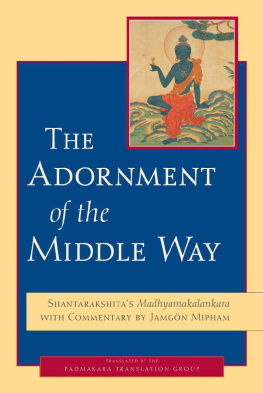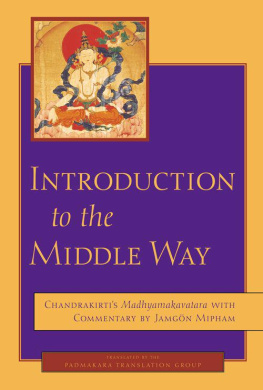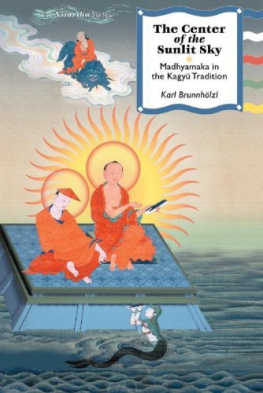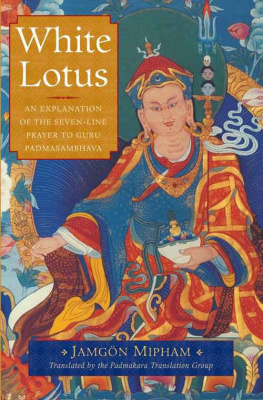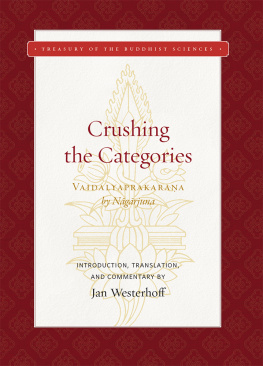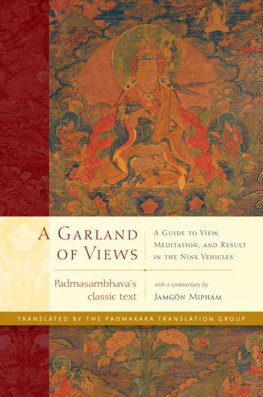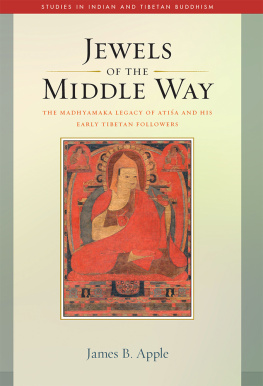Madhyamakalankara with Commentary by Jamgon Mipham

Buddha Shakyamuni
Madhyamakalankara with Commentary by Jamgon Mipham
The Padmakara Translation Group gratefully acknowledges the generous support of the Tsadra Foundation in sponsoring the translation and preparation of this book.
Madhyamakalankara with Commentary by Jamgon Mipham

Madhyamakalankara with Commentary by Jamgon Mipham
T HE A DORNMENT
OF THE
M IDDLE W AY
Shantarakshitas
Madhyamakalankara
with commentary by
Jamgn Mipham
TRANSLATED BY THE
P ADMAKARA T RANSLATION G ROUP

2011
Madhyamakalankara with Commentary by Jamgon Mipham
Shambhala Publications, Inc.
Horticultural Hall
300 Massachusetts Avenue
Boston, Massachusetts 02115
www.shambhala.com
2005 by the Padmakara Translation Group
All rights reserved. No part of this book may be reproduced in any form or by any means, electronic or mechanical, including photocopying, recording, or by any information storage and retrieval system, without permission in writing from the publisher.
Library of Congress Cataloging-in-Publication Data
ntarakita, 705762.
[Madhyamaklakra. English & Tibetan]
The adornment of the middle way: Shantarakshitas Madhyamakalankara with commentary by Jamgn Mipham/translated by the Padmakara Translation Group.1st ed.
p. cm.
Includes bibliographical references and index.
eISBN 978-0-8348-2165-1
ISBN 1-59030-241-9 (alk. paper)
1. ntarakita, 705762. Madhyamaklakra. I. Mi-pham-rgya-mtsho, Jam-mgon Ju, 18461912. Dbu ma rgyan gyi rnam bad Jam dbyas bla ma dgyes pai al lu es bya ba bugs so. II. Padmakara Translation Group. III. Title.
BQ3182.E5S26 2005
294.385dc22
2004023929
Madhyamakalankara with Commentary by Jamgon Mipham
Contents
Madhyamakalankara with Commentary by Jamgon Mipham
Publishers Note
This book contains Sanskrit diacritics and special characters. If you encounter difficulty displaying these characters, please set your e-reader device to publisher defaults (if available) or to an alternate font.
Madhyamakalankara with Commentary by Jamgon Mipham
Foreword
THE MADHYAMAKALANKARA was probably the first Madhyamaka text to be rendered into Tibetan, and it was translated under the auspices and with the guidance of its author. Shantarakshita was famous for the way he presented the conventional truth according to the wisdom of the Mind Only school, which provides the best and most subtle way of understanding the functioning of phenomenal existence. This he combined with the profound view of Madhyamaka as a means of entering the ultimate truth. The Madhyamakalankara is therefore an extraordinary text, for it brings the Mind Only and the Madhyamaka schools together into a single system, thereby unifying the two great traditions of the Mahayana, the Buddhism of the great vehicle. The Madhyamakalankara, the Adornment of the Middle Way, is moreover an ornament for the whole of the Madhyamaka teachings. Not only does it set forth the position of the Svatantrikas, by making a distinction between the two kinds of ultimate truth, but also, when explaining the actual ultimate in itself, it does so in a way that is no different from that of the Prasangikas.
In studying this text, we are reminded of Shantarakshitas immense wisdom and kindness. He was a scholar of encyclopedic learning and his great work the Tattvasamgraha is still studied today as one of the most extensive records of the philosophical schools and traditions of medieval India. It is amazing that, despite his advanced age and the length and difficulty of the journey, Shantarakshita was willing to travel to Tibet where, at the invitation of King Trisongdetsen, he played a crucial role in the establishment of the Dharma. He ordained the first monks and transmitted the entire range of sutra teachings: the vinaya discipline, the Mahayana teachings on bodhichitta, both relative and ultimate and, within that context, the doctrine of the Middle Way. He was also an accomplished master of the Secret Mantra and it was he who advised the king to invite Guru Padmasambhava to come to Tibet. As we know, Guru Rinpoche filled the country with the teachings of the sutras and the tantras, and created an environment in which the full extent of the Buddhadharma could be preserved and practiced for over twelve hundred years. All this happened thanks to the great compassion of Shantarakshita, Guru Padmasambhava, and the Dharma king Trisongdetsen.
We are very happy and grateful to be able to make this text available in Englishnot only the stanzas of Shantarakshita himself, but also the great commentary of Mipham Rinpoche whom our teachers Kyabje Kangyur Rinpoche and Kyabje Dilgo Khyentse Rinpoche met in person and whom they considered to be one of their main teachers. It is certainly thanks to the blessings of these great beings that it has been possible for us to study these texts, the genuine expressions of the Buddhas teaching composed by truly authentic masters and, on the basis of the explanations that we have been fortunate to receive, to make a humble attempt at translating them.
J IGME K HYENTSE
Dordogne, 2004
Madhyamakalankara with Commentary by Jamgon Mipham
Translators Introduction
THIS TRANSLATION of Shantarakshitas Madhyamakalankara and of the commentary on it composed by Jamgn Mipham Rinpoche was made following the detailed explanations given by Khenchen Pema Sherab of Namdrling Monastery, Mysore, India, during four summer study sessions at Chanteloube in Dordogne, France. When first requested to expound these texts, he remarked smilingly on their difficultymuch greater than in the case of the Madhyamakavatara of Chandrakirti, which, despite its profundity, is comparatively straightforward. One of the main challenges for the nonspecialist reader of Shantarakshitas textand even more so that of Miphamis that they presuppose a considerable knowledge of the teachings on pramana, the system of logic and epistemology associated with the Indian masters Dignaga and Dharmakirti. Khen Rinpoche went on to say, however, that one should not allow oneself to be discouraged by such difficulties. For in bringing together the traditions of Madhyamaka and Chittamatra, respectively associated with Nagarjuna and Asanga, the Madhyamakalankara is a key texta valuable tool that facilitates the acquisition of a full and balanced understanding of Mahayana Buddhism. In addition, Miphams commentary on it is widely recognized to be one of his masterpieces. It is a penetrating and wide-ranging analysis, which, in Khen Rinpoches estimation, ranks as one of the most profound commentaries on Madhyamaka ever written. This is all the more amazing when one considers that Mipham composed the work at the age of thirty-one, spent no more than a few hours on it each day, and completed the task in three weeks!
Given the difficult and intricate questions discussed in Miphams commentary and the appeal that it is likely to have for students who are already familiar with Madhyamaka ideas, it is unnecessary in the present introduction to discuss basic principles, presentations of which are readily available elsewhere. Instead, in order to place the present work in context, we wish only (and with all due diffidence) to draw the readers attention to certain important issues that may help to explain the reason for Miphams composition as well as its remarkably fresh and invigorating approach to what is indeed a profound and interesting subject. In addition to supplying a brief biographical note on Shantarakshita, therefore, we have attempted to review briefly three questions: the Svatantrika-Prasangika distinction, which Mipham himself discusses at some length; the role played by the Yogachara or Chittamatra doctrine in Shantarakshitas synthesis; and certain logical and epistemological issues that will perhaps be unfamiliar to the nonspecialist.
Next page 
